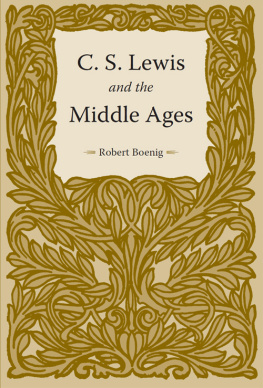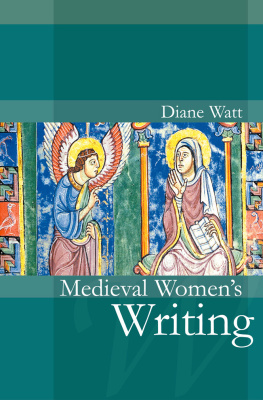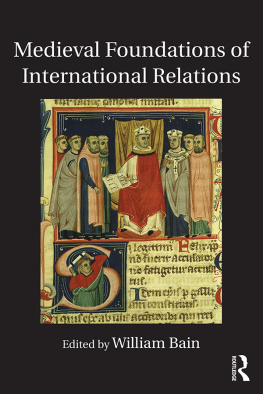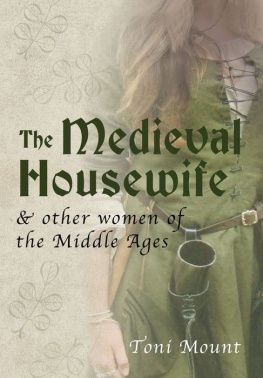MEDIEVAL THEORY OF AUTHORSHIP
Second Edition
with a New Preface by the Author
THE MIDDLE AGES SERIES
Ruth Mazo Karras, Series Editor
Edward Peters, Founding Editor
A complete list of books in the series
is available from the publisher.
MEDIEVAL THEORY
OF AUTHORSHIP
Scholastic Literary Attitudes
in the Later Middle Ages
Second Edition
with a New Preface by the Author
Alastair Minnis

First published in 1984 by Scolar Press.
Second edition first published in 1988 by University of Pennsylvania Press.
Copyright 2010 University of Pennsylvania Press
All rights reserved. Except for brief quotations used for purposes of review or scholarly citation, none of this book may be reproduced in any form by any means without written permission from the publisher.
Published by
University of Pennsylvania Press
Philadelphia, Pennsylvania 19104-4112
Printed in the United States of America on acid-free paper
10 9 8 7 6 5 4 3 2 1
A Cataloging-in-Publication Record is
available from the Library of Congress
ISBN 978-0-8122-1257-0
IN MEMORY OF MY PARENTS
SARAH ELIZABETH MINNIS
ALEXANDER ORR SIMPSON MINNIS
Contents
Preface to the Reissued Second Edition
This is a reprint of the second edition of Medieval Theory of Authorship, as originally published in 1988 (the first edition having appeared in 1984). I am grateful to the University of Pennsylvania Press, the original American publisher of the second edition, for reissuing it in this form, and for inviting me to offer the following reflections, some twenty-two years later, on the significance of its materials.
I begin with reference to a previous preface: Beryl Smalleys introduction to the third edition (published in 1984) of her monumental Study of the Bible in the Middle Ages. The retractions there offered include an expression of regret for her elevation of the literal sense of Scripture over its spiritual senses; in large measure this was a result of her concentration on the exegesis produced by university-educated friars rather than the work of monastic communities. And she certainly had a blind spot concerning Joachim of Fiore (d. 1202), whose reformist apocalypticism was of far greater cultural significance than she originally had allowed. But nevertheless it seems to me that, in the history of medieval theories of the senses of Scripture, Smalleys controversial heading, The Spiritual Exposition in Decline, still has much life in it. There are many testimonies to the new prestige and scope which the literal sense came to enjoy, within thirteenth-century schools of theology and beyond. Take, for instance, the paradoxical notion of a double literal sense, as discussed by such major scholars as Nicholas of Lyre (d. 1349) and William of Nottingham (d. c. 1336). The details need not concern us here, Second, the literal sense is fixed, determinate, single, and incapable of being changed by us, whereas the spiritual senses can be assigned as we wish; mean whatever we want them to mean. Third, the sensus litteralis is verifiable, that is, it can be adjudged to be true or false, which cannot be done with a spiritual sense. Fourth, Scripture cannot be completed or fulfilled in its mystical sense but only in its literal sense, for only a sense which is either true or false can be verified as fulfilled or not. Fifth, arguments may be drawn only from the literal sense of Scripture. The spiritual sense cannot prove anything because we cannot say that a given passage is true or false in its spiritual sense, only in its literal sense. Spiritual senses are uncertain since it is not evident whether one spiritual exposition is the sense of a given passage rather than another. Indeed, a single passage can have disparate and opposing spiritual senses, and so one and the same passage could be cited in arguing for different and contradictory things. All of this renders the spiritual sense impossible to use when one is trying to prove something. In short, only from the literal sense may proof in argument be drawn.
That last statement is an elaboration of a passage in Thomas Aquinass Summa theologiae (a crucial source for Lyre also): All argument must derive from this [the sensus litteralis] alone, and not from what is said in the allegorical sense, as Augustine says in the letter against Vincent the Donatist (cf. pp. 7374 below). Our schoolmen took that to mean rigorously logical, syllogistic argumentation. Thus understood, the principle was to resonate across several centuries of Scriptural exegesis, and to be enlisted in many a controversy, including some which had ramifications far beyond the narrow confines of the schools. Take, for instance, William of Ockhams attack on an understanding of the two swords mentioned at Luke 22:38 (and generally read as signifying the competing powers of church and state) which went against the interests of his patron and protector, Ludwig of Bavaria.a spiritual sense which lacks the confirmation of a literal sense found elsewhere in Scripture, it therefore lacks credibility. Citing Augustines letter against Vincent, Ockham declares that in disputation an allegorical sense cannot be adduced unless it is explicit in Scripture, because if it cannot be proved explicitly by Scripture his opponent will say that it can be as easily despised as approved. Anyone can make up (fingit) a spiritual sense according to the strength of his own wit. Whereas John of Pariss treatise De potestate regia et papali (c. 1302)a major influence on Ockhams Breviloquiumattacks various allegorical readings of Luke 22:38 which his opponents had adduced, Ockham goes farther, in dismissing allegory tout court as a means of reaching secure truth in the matter under discussion.
Analysis such as this dealt a powerful blow to the status of the allegorical reading of the Bible as an academic procedure. St Pauls dictum, the letter killeth, but the spirit quickeneth (II Cor. 3:6), had often been cited in monastic exegesis to affirm the superiority of the spiritual sense over the literal sense, even as the kernel far exceeds in value the husk of a nut.
But this is not to say that allegory was made redundant. The evidence I have just summarized could equally well be interpreted as indicating that much of its business had actually been relocated, brought under new management, as it were. Furthermore, even a cursory reading of the quaestiones produced in the thirteenth and fourteenth centuries makes it abundantly clear that the spiritual sense was not banished from the classroom. In interpreting and appropriating Biblical auctoritates, the schoolmen were fully prepared to offer one type of exegesis in one place and another type in another, bending the waxen nose of authority (cf. p. 143 below) to take on different meanings, whether literal or allegorical. The attack on the truth-value of allegorical exegesis which I quoted And in this same treatise Ockham does indeed adduce mystical sense in support of his thesis.
In practice what often mattered was not whether the Bible should be interpreted in one way or another but rather such pragmatic considerations as the specific pedagogic purpose of the given interpretation and the perceived nature and needs of its target-audience. It was widely admitted that allegory had an important part to play in the sphere of dificatio (building up the faith) and exhortatio (pious exhortation, as in sermons). Alfonso de Madrigal found nothing incongruous in affirming the superiority of literal sense over spiritual sense (as quoted above) while planning a bigger and better version of that same treatise of Lyres. In sum, the methodologies of medieval exegesis were a lot more flexible and context-specific than has sometimes been allowed.
Next page







